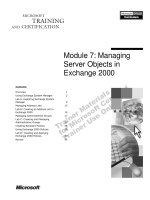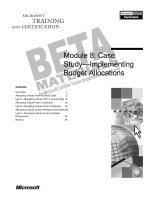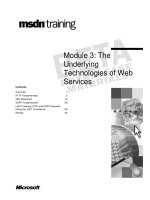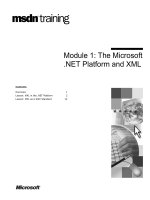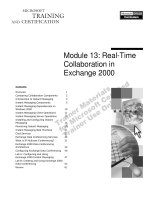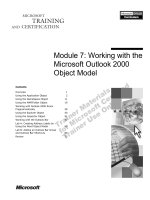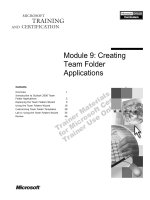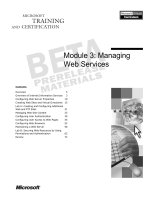Tài liệu Module 14: Attributes pptx
Bạn đang xem bản rút gọn của tài liệu. Xem và tải ngay bản đầy đủ của tài liệu tại đây (847.73 KB, 40 trang )
Contents
Overview 1
Overview of Attributes 2
Defining Custom Attributes 13
Retrieving Attribute Values 22
Lab 14.1: Defining and Using Attributes 26
Review 34
Course Evaluation 36
Module 14: Attributes
Information in this document, including URL and other Internet Web site references, is subject to
change without notice. Unless otherwise noted, the example companies, organizations, products,
domain names, e-mail addresses, logos, people, places, and events depicted herein are fictitious,
and no association with any real company, organization, product, domain name, e-mail address,
logo, person, places or events is intended or should be inferred. Complying with all applicable
copyright laws is the responsibility of the user. Without limiting the rights under copyright, no
part of this document may be reproduced, stored in or introduced into a retrieval system, or
transmitted in any form or by any means (electronic, mechanical, photocopying, recording, or
otherwise), or for any purpose, without the express written permission of Microsoft Corporation.
Microsoft may have patents, patent applications, trademarks, copyrights, or other intellectual
property rights covering subject matter in this document. Except as expressly provided in any
written license agreement from Microsoft, the furnishing of this document does not give you any
license to these patents, trademarks, copyrights, or other intellectual property.
2001−2002 Microsoft Corporation. All rights reserved.
Microsoft, MS-DOS, Windows, Windows NT, ActiveX, BizTalk, IntelliSense, JScript, MSDN,
PowerPoint, SQL Server, Visual Basic, Visual C++, Visual C#, Visual J#, Visual Studio, and
Win32 are either registered trademarks or trademarks of Microsoft Corporation in the U.S.A.
and/or other countries.
The names of actual companies and products mentioned herein may be the trademarks of their
respective owners.
Module 14: Attributes iii
Instructor Notes
Teach this module if time permits. Module 14 is a stand-alone module that does
not have anything else dependent upon it.
This module provides students with the details about how to use attributes in
code. It describes the predefined attributes that are provided by the Microsoft
®
.NET Framework and provides some simple examples of how to use some
common attributes. The concept of custom attributes is introduced. This
introduction is followed by a detailed explanation of how to define and use
custom attributes. The process used to compile code that has custom attributes
is also explained. Finally, the module describes how to retrieve attribute values
during run time by using reflection. The procedure that is used to retrieve
attribute information into an array and query the array to obtain the required
values is explained.
After completing this module, students will be able to:
Use common predefined attributes.
Create simple custom attributes.
Query attribute information at run time.
Materials and Preparation
This section provides the materials and preparation tasks that you need to teach
this module.
Required Materials
To teach this module, you need the following materials:
Microsoft PowerPoint® file 2124C_14.ppt
Module 14, “Attributes”
Lab 14, Defining and Using Attributes
Preparation Tasks
To prepare for this module, you should:
Read all of the materials for this module.
Complete the lab.
Read the instructor notes and margin notes for the module.
Practice using Intermediate Language Disassembler (ILDASM) to examine
the metadata of an assembly.
Presentation:
60 Minutes
Lab:
45 Minutes
iv Module 14: Attributes
Module Strategy
Use the following strategy to present this module:
Overview of Attributes
Begin by explaining that attributes are only annotations to classes and
perform no function themselves. Before attributes can cause an action,
certain code must be implemented. This code is in the runtime for the
predefined attributes and is written by the developer for custom attributes.
Explain the syntax used to apply an attribute, and, after covering the lists of
predefined attributes briefly, discuss the three attributes—Conditional,
DllImport, and Transaction—using examples.
Defining Custom Attributes
Introduce the need for creating custom attributes, and explain the procedures
involved in defining a custom attribute. Explain the use of AttributeUsage
and how to create an attribute class. Then explain the details of the
procedure used to compile code that uses custom attributes. Finish the
section by explaining how to use multiple attributes in code.
Retrieving Attribute Values
In this section, introduce the concept of retrieving attribute values at run
time by using reflection. Explain how to use the MemberInfo class and the
typeof operator to obtain attribute values. Finally, discuss how to iterate
through the stored attribute values in an array to retrieve the required values.
To end the discussion about attributes, use the review slide to recapitulate
the main concepts covered in the module.
Module 14: Attributes 1
Overview
Overview of Attributes
Defining Custom Attributes
Retrieving Attribute Values
*****************************
ILLEGAL FOR NON-TRAINER USE******************************
Attributes are a simple technique for adding metadata to classes. They can be
useful when you need to build components.
In this module, you will learn the purpose of attributes and the function that
they perform in C# applications. You will learn about attribute syntax and how
to use some of the predefined attributes in the Microsoft
® .NET Framework
environment. You will also learn to create custom user-defined attributes.
Finally, you will learn how classes and other object types can implement and
use these custom attributes to query attribute information at run time.
After completing this module, you will be able to:
Use common predefined attributes.
Create simple custom attributes.
Query attribute information at run time.
Topic Objective
To provide an overview of
the module topics and
objectives.
Lead-in
In this module, you will learn
about using attributes in C#.
Delivery Tip
Teach this module if time
permits. This is a stand-
alone module that does not
have anything else
dependent upon it.
2 Module 14: Attributes
Overview of Attributes
Introduction to Attributes
Applying Attributes
Common Predefined Attributes
Using the Conditional Attribute
Using the DllImport Attribute
Using the Transaction Attribute
*****************************
ILLEGAL FOR NON-TRAINER USE******************************
With the introduction of attributes, the C# language provides a convenient
technique that will help handle tasks such as changing the behavior of the
runtime, obtaining transaction information about an object, conveying
organizational information to a designer, and handling unmanaged code.
After completing this lesson, you will be able to:
Identify which tasks you can perform with attributes.
Use the syntax for using attributes in your code.
Identify some of the predefined attributes that are available in the .NET
Framework.
Topic Objective
To introduce the topics
covered in this section.
Lead-in
In this section, you will learn
what attributes are and how
they are used.
Module 14: Attributes 3
Introduction to Attributes
Attributes are:
Declarative tags that convey information to the runtime
Stored with the metadata of the element
.NET Framework provides predefined attributes
The runtime contains code to examine values of
attributes and act on them
*****************************
ILLEGAL FOR NON-TRAINER USE******************************
The .NET Framework provides attributes so that you can extend the capabilities
of the C# language. An attribute is a declarative tag that you use to convey
information to the runtime about the behavior of programmatic elements such
as classes, enumerators, and assemblies.
You can think of attributes as annotations that your programs can store and use.
In most cases, you write the code that retrieves the values of an attribute in
addition to the code that performs a change in behavior at run time. In its
simplest form, an attribute is an extended way to document your code.
You can apply attributes to many elements of the source code. Information
about the attributes is stored with the metadata of the elements they are
associated with.
The .NET Framework is equipped with a number of predefined attributes. The
code to examine them and act upon the values they contain is also incorporated
as a part of the runtime and .NET Framework SDK.
Topic Objective
To define attributes.
Lead-in
The concept of an attribute
is simple.
Delivery Tip
Stress that attributes are
fundamentally a very simple
idea—they are simply
annotations for your code
that are intended to convey
useful declarative
information.
4 Module 14: Attributes
Applying Attributes
Syntax: Use square brackets to specify an attribute
To apply multiple attributes to an element, you can:
Specify multiple attributes in separate square brackets
Use a single square bracket and separate attributes with
commas
For some elements such as assemblies, specify the
element name associated with the attribute explicitly
[attribute(positional_parameters,named_parameter=value, )]
element
[attribute(positional_parameters,named_parameter=value, )]
element
*****************************
ILLEGAL FOR NON-TRAINER USE******************************
You can apply attributes to different kinds of programming elements. These
elements include assemblies, modules, classes, structs, enums, constructors,
methods, properties, fields, events, interfaces, parameters, return values, and
delegates.
Attribute Syntax
To specify an attribute and associate it with a programming element, use the
following general syntax:
[attribute(positional_parameters,name_parameter=value, )]
element
You specify an attribute name and its values within square brackets ([ and ])
before the programmatic element to which you want to apply the attribute. Most
attributes take one or more parameters, which can be either positional or
named.
You specify a positional parameter in a defined position in the parameter list, as
you would specify parameters for methods. Any named parameter values
follow the positional parameters. Positional parameters are used to specify
essential information, whereas named parameters are used to convey optional
information in an attribute.
Before using an unfamiliar attribute, it is a good practice to check the
documentation for the attribute to find out which parameters are available and
whether they should be positional or named.
Topic Objective
To explain the syntax for
using attributes.
Lead-in
Attributes can be applied to
several different types of
programming elements.
Tip
Module 14: Attributes 5
Example
As an example of using attributes, consider the following code, in which the
DefaultEvent attribute is applied on a class by using a positional string
parameter, ShowResult:
using System.ComponentModel;
[DefaultEvent("ShowResult")]
public class Calculator: System.Windows.Forms.UserControl
{
}
Applying Multiple Attributes
You can apply more than one attribute to an element. You can enclose each
attribute in its own set of square brackets, although you can also enclose
multiple attributes, separated with commas, in the same set of square brackets.
In some circumstances, you must specify exactly which element an attribute is
associated with. For example, in the case of assembly attributes, place them
after any using clauses but before any code, and explicitly specify them as
attributes of the assembly.
The following example shows how to use the CLSCompliant assembly
attribute. This attribute indicates whether or not an assembly strictly conforms
to the Common Language Specification.
using System;
[assembly:CLSCompliant(true)]
class MyClass
{
}
6 Module 14: Attributes
Common Predefined Attributes
.NET provides many predefined attributes
General attributes
COM interoperability attributes
Transaction handling attributes
Visual designer component building attributes
*****************************
ILLEGAL FOR NON-TRAINER USE******************************
The capabilities of predefined attributes in the .NET Framework encompass a
wide range of areas, from interoperability with COM to compatibility with
visual design tools.
This topic describes some of the common predefined attributes that are
provided by the .NET Framework. However, it is not intended to be
comprehensive. For more information about predefined attributes, refer to the
Microsoft Visual Studio
® .NET Help documents.
General Attributes
The following list summarizes some of the general attributes that are provided
by the .NET Framework.
Attribute Applicable to Description
Conditional Method Tests to see whether a named symbol is
defined. If it is defined, any calls to the
method are executed normally. If the symbol
is not defined, the call is not generated.
DllImport Method Indicates that the method is implemented in
unmanaged code, in the specified DLL. It
causes the DLL to be loaded at run time and
the named method to execute.
Topic Objective
To list some common
predefined attributes.
Lead-in
The .NET Framework
provides a large number of
predefined attributes.
Module 14: Attributes 7
COM Interoperability Attributes
When using the attributes to provide interoperability with COM, the goal is to
ensure that using COM components from the managed .NET Framework
environment is as seamless as possible. The .NET Framework has many
attributes relating to COM interoperability. Some of these are listed in the
following table.
Attribute Applicable to Description
ComImport Class/Interface Indicates that a class or interface
definition was imported from a COM
type library.
ComRegisterFunction Method Specifies the method to be called when a
.NET Framework assembly is registered
for use from COM.
ComUnregisterFunction Method Specifies the method to be called when a
.NET assembly is unregistered for use
from COM.
DispId Method, field,
property
Indicates which dispatch ID is to be used
for the method, field or property.
In parameter Indicates that the data should be
marshaled from the caller to the callee.
MarshalAs Field,
parameter,
return values
Specifies how data should be marshaled
between COM and the managed
environment.
ProgId Class Specifies which prog ID is to be used for
the class.
Out parameter Indicates that data should be marshaled
from the callee back to caller.
InterfaceType Interface Specifies whether a managed interface is
IDispatch, IUnknown, or dual when it
is exposed to COM.
For more information about COM interoperability, search for “Microsoft
ComServices” in the .NET Framework SDK Help documents.
Transaction Handling Attributes
Components running in a COM+ environment use transaction management.
The attribute you use for this purpose is shown in the following table.
Attribute Applicable to Description
Transaction Class Specify the type of transaction that should be
available to this object.
Delivery Tip
Avoid getting into long
conversations about COM,
transactions, and
interoperability because this
is beyond the scope of this
course. This information is
presented to show that the
.NET Framework is
compatible with COM.
8 Module 14: Attributes
Visual Designer Component-Building Attributes
Developers who build components for a visual designer use the attributes listed
in the following table.
Attribute Applicable to Description
Bindable Property Specifies whether a property is typically used
for binding.
DefaultProperty Class Specifies the default property for the
component.
DefaultValue Property Indicates that the property is the default value
for the component.
Localizable Property When code is generated for a component,
members that are marked with
Localizable(true) have their property values
saved in resource files. You can localize these
resource files without modifying the code.
DefaultEvent Class Specifies the default event for the component.
Category Property,
event
Specifies the category into which the visual
designer should place this property or event in
the property window.
Description Property,
event
Defines a brief piece of text to be displayed at
the bottom of the property window in the visual
designer when this property or event is selected.
Module 14: Attributes 9
Using the Conditional Attribute
Serves as a debugging tool
Causes conditional compilation of method calls, depending on the
value of a programmer-defined symbol
Does not cause conditional compilation of the method itself
Restrictions on methods
Must have return type of void
Must not be declared as override
Must not be from an inherited interface
using System.Diagnostics;
class MyClass
{
[Conditional ("DEBUGGING")]
public static void MyMethod( )
{
}
}
using System.Diagnostics;
class MyClass
{
[Conditional ("DEBUGGING")]
public static void MyMethod( )
{
}
}
*****************************
ILLEGAL FOR NON-TRAINER USE******************************
You can use the Conditional attribute as a debugging aid in your C# code. This
attribute causes conditional compilation of method calls, depending on the
value of a symbol that you define. It lets you invoke methods that, for example,
display the values of variables, while you test and debug code. After you have
debugged your program, you can “undefine” the symbol and recompile your
code without changing anything else. (Or you can simply remove the symbol
from the command line, and not change anything.)
Example
The following example shows how to use the Conditional attribute. In this
example, the MyMethod method in MyClass is tagged with the Conditional
attribute by the symbol DEBUGGING:
using System.Diagnostics;
class MyClass
{
[Conditional ("DEBUGGING")]
public static void MyMethod( )
{
}
}
Topic Objective
To show how to use the
Conditional attribute.
Lead-in
The Conditional attribute is
frequently used for
debugging classes.
Delivery Tip
The Conditional attribute is
common and is used in the
labs. Make sure students
understand how to use it.
10 Module 14: Attributes
The symbol DEBUGGING is defined as follows:
#define DEBUGGING
class AnotherClass
{
public static void Test( )
{
MyClass.MyMethod( );
}
}
As long as the symbol DEBUGGING remains defined when the method call is
compiled, the method call will operate normally. When DEBUGGING is
undefined, the compiler will omit calls to the method. Therefore, when you run
the program, it will be treated as though that line of code does not exist.
You can define the symbol in one of two ways. You can either add a #define
directive to the code as shown in the preceding example, or define the symbol
from the command line when you compile your program.
Restrictions on Methods
The methods to which you can apply a Conditional attribute are subject to a
number of restrictions. In particular, they must have a return type of void, they
must not be marked as override, and they must not be the implementation of a
method from an inherited interface.
The Conditional attribute does not cause conditional compilation of the
method itself. The attribute only determines the action that will occur when the
method is called. If you require conditional compilation of a method, then you
must use the #if and #endif directives in your code.
Note
Module 14: Attributes 11
Using the DllImport Attribute
With the DllImport attribute, you can:
Invoke unmanaged code in DLLs from a C# environment
Tag an external method to show that it resides in an
unmanaged DLL
using System.Runtime.InteropServices;
public class MyClass( )
{
[DllImport("MyDLL.dll", EntryPoint="MyFunction")]
public static extern int MyFunction(string param1);
int result = MyFunction("Hello Unmanaged Code");
}
using System.Runtime.InteropServices;
public class MyClass( )
{
[DllImport("MyDLL.dll", EntryPoint="MyFunction")]
public static extern int MyFunction(string param1);
int result = MyFunction("Hello Unmanaged Code");
}
*****************************
ILLEGAL FOR NON-TRAINER USE******************************
You can use the DllImport attribute to invoke unmanaged code in your C#
programs. Unmanaged code is the term used for code that has been developed
outside the .NET environment (that is, standard C compiled into DLL files). By
using the DllImport attribute, you can invoke unmanaged code residing in
dynamic-link libraries (DLLs) from your managed C# environment.
Invoking Unmanaged Code
The DllImport attribute allows you to tag an extern method as residing in an
unmanaged DLL. When your code calls this method, the common language
runtime locates the DLL, loads it into the memory of your process, marshals
parameters as necessary, and transfers control to the address at the beginning of
the unmanaged code. This is unlike a normal program, which does not have
direct access to the memory that is allocated to it. The following code provides
an example of how to invoke unmanaged code:
using System.Runtime.InteropServices;
public class MyClass( )
{
[DllImport("MyDLL.dll", EntryPoint="MyFunction")]
public static extern int MyFunction(string param1);
int result = MyFunction("Hello Unmanaged Code");
}
Topic Objective
To explain how to use the
DllImport attribute.
Lead-in
The DllImport attribute is
used to handle unmanaged
code.
12 Module 14: Attributes
Using the Transaction Attribute
To manage transactions in COM+
Specify that your component be included when a
transaction commit is requested
Use a Transaction attribute on the class that implements
the component
using System.EnterpriseServices;
[Transaction(TransactionOption.Required)]
public class MyTransactionalComponent
{
}
using System.EnterpriseServices;
[Transaction(TransactionOption.Required)]
public class MyTransactionalComponent
{
}
*****************************
ILLEGAL FOR NON-TRAINER USE******************************
It is likely that, as a Microsoft Visual Basic
® or C++ developer working in a
Microsoft environment, you are familiar with technologies such as COM+. An
important feature of COM+ is that it allows you to develop components that can
participate in distributed transactions, which are transactions that can span
multiple databases, machines, and components.
Managing Transactions in COM+
Writing code to guarantee a correct transaction commit in a distributed
environment is difficult. However, if you use COM+, it takes care of managing
the transactional integrity of the system and coordinating events on the network.
In this case, you only need to specify that your component be included when an
application that uses your component requests a transaction commit. To make
this specification, you can use a Transaction attribute on the class that
implements the component, as follows:
using System.EnterpriseServices;
[Transaction(TransactionOption.Required)]
public class MyTransactionalComponent
{
}
The Transaction attribute is one of the predefined .NET Framework attributes
that the .NET Framework runtime interprets automatically.
Topic Objective
To show how to use the
Transaction attribute.
Lead-in
The Transaction attribute is
used to manage
transactions.
Module 14: Attributes 13
Defining Custom Attributes
Defining Custom Attribute Scope
Defining an Attribute Class
Processing a Custom Attribute
Using Multiple Attributes
*****************************
ILLEGAL FOR NON-TRAINER USE******************************
When you encounter a situation in which none of the predefined .NET
Framework attributes satisfy your requirements, you can create your own
attribute. Such a custom attribute will provide properties that allow you to store
and retrieve information from the attribute.
Like predefined attributes, custom attributes are objects that are associated with
one or more programmatic elements. They are stored with the metadata of their
associated elements, and they provide mechanisms for a program to retrieve
their values.
After completing this lesson, you will be able to:
Define your own custom attributes.
Use your own custom attributes.
Topic Objective
To introduce the topics
covered in this section.
Lead-in
You can define your own
custom attributes.
14 Module 14: Attributes
Defining Custom Attribute Scope
Use the AttributeUsage tag to define scope
Example
Use the bitwise “or” operator (|) to specify multiple
elements
Example
[AttributeUsage(AttributeTargets.Class | AttributeTargets.Struct)]
public class MyAttribute: System.Attribute
{ }
[AttributeUsage(AttributeTargets.Class | AttributeTargets.Struct)]
public class MyAttribute: System.Attribute
{ }
[AttributeUsage(AttributeTargets.Method)]
public class MyAttribute: System.Attribute
{ }
[AttributeUsage(AttributeTargets.Method)]
public class MyAttribute: System.Attribute
{ }
*****************************
ILLEGAL FOR NON-TRAINER USE******************************
As with some predefined attributes, you must explicitly specify the
programming element to which you want to apply a custom attribute. To do so,
you annotate your custom attribute with an AttributeUsage tag as shown in the
following example:
[AttributeUsage(target_elements)]
public class MyAttribute: System.Attribute
{ }
Defining Attribute Scope
The parameter to AttributeUsage contains values from the
System.AttributeTargets enumeration to specify how the custom attribute can
be used. The members of this enumeration are summarized in the following
table.
Member name Attribute can be applied to
Class class
Constructor constructor
Delegate delegate
Enum enum
Event event
Field field
Interface interface
Method method
Module module
Topic Objective
To describe the scope of a
custom attribute.
Lead-in
You need to scope your
custom attribute to define
the elements that can use
your custom attribute.
Module 14: Attributes 15
(continued)
Member name Attribute can be applied to
Parameter parameter
Property property
ReturnValue return value
Struct struct
Assembly assembly
All Any element
Example of Using Custom Attributes
To specify that the MyAttribute custom attribute can be applied only to
methods, use the following code:
[AttributeUsage(AttributeTargets.Method)]
public class MyAttribute: System.Attribute
{
}
Specifying Multiple Elements
If the attribute can be applied to more than one element type, use the bitwise
“or” operator (|) to specify multiple target types. For example, if MyAttribute
can also be applied to constructors, the earlier code will be modified as follows:
[AttributeUsage(AttributeTargets.Method |
AttributeTargets.Constructor)]
public class MyAttribute: System.Attribute
{
}
If a developer attempts to use the MyAttribute in a context different from that
which is defined by AttributeUsage, the developer’s code will not compile.
16 Module 14: Attributes
Defining an Attribute Class
Deriving an attribute class
All attribute classes must derive from System.Attribute,
directly or indirectly
Suffix name of attribute class with “Attribute”
Components of an attribute class
Define a single constructor for each attribute class by
using a positional parameter
Use properties to set an optional value by using a
named parameter
*****************************
ILLEGAL FOR NON-TRAINER USE******************************
After you define the scope of a custom attribute, you need to specify the way
you want the custom attribute to behave. For this purpose, you must define an
attribute class. Such a class will define the name of the attribute, how it can be
created, and the information that it will store.
The .NET Framework SDK provides a base class, System.Attribute, that you
must use to derive custom attribute classes and to access the values held in
custom attributes.
Deriving an Attribute Class
All custom attribute classes must derive from System.Attribute, either directly
or indirectly. The following code provides an example:
public class DeveloperInfoAttribute: System.Attribute
{
public DeveloperInfoAttribute(string developer)
{
}
public string Date
{
get { }
set { }
}
}
It is a good practice to append the name of a custom attribute class with the
suffix “Attribute,” as in DeveloperInfoAttribute. This makes it easier to
distinguish the attribute classes from the non-attribute classes.
Topic Objective
To describe what attribute
classes are and how they
are defined.
Lead-in
To define custom attributes,
you must first define an
attribute class.
Delivery Tip
Use the terminology
carefully. Talking about
attributes having attributes
could be confusing to some
students.
Key Points
1. Always append the suffix
“Attribute” to the end of
custom attribute classes.
2. Custom attribute classes
must descend from
System.Attribute.
Module 14: Attributes 17
Components of an Attribute Class
All attribute classes must have a constructor. For example, if the
DeveloperInfo attribute expects the name of the developer as a string
parameter, it must have a constructor that accepts a string parameter.
A custom attribute must define a single constructor that sets the mandatory
information. The positional parameter or parameters of the attribute pass this
information to the constructor. If an attribute has optional data, then it is
attempting to overload the constructor. This is not a good practice to adopt. Use
named parameters to provide optional data.
An attribute class can, however, provide properties to get and set data.
Therefore, you must use properties to set optional values, if required. Then a
developer can specify the optional values as named parameters when using the
attribute.
For example, the DeveloperInfoAttribute provides a Date property. You can
call the set method of the Date property to set the named parameter: Date. The
developer name, Bert, for example, is the positional parameter that is passed to
the constructor of the attribute:
[DeveloperInfoAttribute("Bert", Date="08-28-2001")]
public class MyClass
{
}
18 Module 14: Attributes
Processing a Custom Attribute
The Compilation Process
1. Searches for the attribute class
2. Checks the scope of the attribute
3. Checks for a constructor in the attribute
4. Creates an instance of the object
5. Checks for a named parameter
6. Sets field or property to named parameter value
7. Saves current state of attribute class
*****************************
ILLEGAL FOR NON-TRAINER USE******************************
When the compiler encounters an attribute on a programming element, the
compiler uses the following process to determine how to apply the attribute:
1. Searches for the attribute class
2. Checks the scope of the attribute
3. Checks for a constructor in the attribute
4. Creates an instance of the object
5. Checks for a named parameter
6. Sets the field or property to a named parameter value
7. Saves the current state of the attribute class
To be completely accurate, the compiler actually verifies that it could apply the
attribute, and then stores the information to do so in the metadata. The compiler
does not create attribute instances at compile time.
Topic Objective
To describe how the
compiler processes a
custom attribute.
Lead-in
In this topic, you will see the
process that occurs when
the compiler encounters an
attribute on a program
element.
Module 14: Attributes 19
Example
To learn more about how the compiler handles attributes, consider the
following example:
[AttributeUsage(AttributeTargets.Class)]
public class DeveloperInfoAttribute: System.Attribute
{
}
{
}
[DeveloperInfo("Bert", Date="08-28-2001")]
public class MyClass
{
}
As is mentioned in the previous topic, it is a good practice to add the
suffix “Attribute” to the name of an attribute class. Strictly speaking, it is not
necessary to do so. Even if you omit the Attribute suffix as shown in the
example, your code will still compile correctly. However, without the Attribute
suffix there are potential issues concerning how the compiler searches for
classes. Always use the Attribute suffix.
The Compilation Process
In the preceding example, when MyClass is compiled, the compiler will search
for an attribute class called DevloperInfoAttribute. If the class cannot be
located, the compiler will then search for DeveloperInfo.
After it finds DeveloperInfo, the compiler will check whether the attribute is
allowed on a class. Then it will check for a constructor that matches the
parameters specified in the attribute use. If it finds one, it creates an instance of
the object by calling the constructor with the specified values.
If there is a named parameter, the compiler matches the name of the parameter
with a field or property in the attribute class, and then sets the field or property
to the specified value. Then the current state of the attribute class is saved to the
metadata for the program element on which it is applied.
Note
20 Module 14: Attributes
Using Multiple Attributes
An element can have more than one attribute
Define both attributes separately
An element can have more than one instance of the
same attribute
Use AllowMultiple = true
*****************************
ILLEGAL FOR NON-TRAINER USE******************************
You can apply more than one attribute to a programming element, and you can
use multiple instances of the same attribute in an application.
Using Multiple Attributes
You can apply more than one attribute to a programming element. For example,
the following code shows how you can tag the FinancialComponent class with
two attributes: Transaction and DefaultProperty.
[Transaction(TransactionOption.Required)]
[DefaultProperty("Balance")]
public class FinancialComponent: System.Attribute
{
public long Balance
{
}
}
Topic Objective
To describe how the same
attribute can be applied
multiple times to the same
programming element.
Lead-in
Depending upon the
circumstances, it might be
useful to use a custom
attribute multiple times on
the same element.
Module 14: Attributes 21
Using the Same Attribute Multiple Times
The default behavior of a custom attribute does not permit multiple instances of
the attribute. However, under some circumstances it might make sense to allow
an attribute to be used on the same element more than once.
An example of this is the custom attribute DeveloperInfo. This attribute allows
you to record the name of the developer that wrote a class. If more than one
developer was involved in the development, you need to use the DeveloperInfo
attribute more than once. For an attribute to permit this, you must mark it as
AllowMultiple in the AttributeUsage attribute, as follows:
[AttributeUsage(AttributeTargets.Class, AllowMultiple=true)]
public class DeveloperInfoAttribute: System.Attribute
{
}
Delivery Tip
Stress that the default
behavior of a custom
attribute is that it does not
permit its multiple use.
